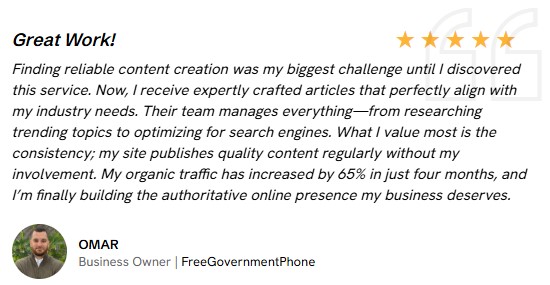
💪 The Challenge
When we first encountered this project, we knew we were facing an uphill battle with extraordinary potential. Our client operates in a specialized niche—helping eligible Americans access free phone services through government assistance programs. While the competition was surprisingly low, the business opportunity was massive, serving millions of Americans who qualify for these essential services.
The starting metrics were humbling, to say the least:
Domain Rating (DR): A mere 0.5 when we began (later growing to 1.7)
Domain Age: While technically an "aged domain," it had minimal established authority
Existing Rankings: Practically nonexistent
Organic Traffic: Minimal to zero
Despite these challenges, the domain possessed a brandable, authoritative-sounding name—a small but significant advantage we could leverage in our strategy.

Our mission was clear but ambitious: establish complete topical authority around the Affordable Connectivity Program (ACP) and Lifeline Program—the two primary government initiatives offering free and discounted phone services to qualifying low-income Americans, seniors, and veterans.
💡 Our Strategic Masterplan
Rather than rushing to publish content, we invested significant time developing a comprehensive topical authority map—a decision that would prove crucial to our success. After thorough research and SERP analysis, we identified a powerful geographic-focused approach.

Our multi-layered strategy included:
- State-by-State Dominance Approach: We created dedicated content clusters for all 50 states (e.g., "Free Government Phones in Alabama," "California Lifeline Phone Providers"), ensuring comprehensive coverage nationwide.
- Strategic Keyword Balancing: We deliberately targeted a mix of:
- High-competition, high-volume national terms
- Moderate-competition state-specific keywords
- Long-tail, low-competition phrases with high conversion potential
- Comprehensive Program Coverage: We developed in-depth, authoritative content explaining eligibility requirements, application processes, and provider comparisons for both the ACP and Lifeline programs.
- User-Intent Optimization: Each piece was crafted to address specific user journeys—from program discovery to application completion—with clear CTAs and next steps.
🏆 The Remarkable Results That Exceeded Expectations
The performance metrics after just three months surpassed even our most optimistic projections:
- 62.11% of targeted keywords ranked in Google's top 100—an extraordinary achievement for a domain with DR under 2
- 8 high-value keywords reached top 3 positions (representing 4.9% of our keyword portfolio)
- 27 keywords secured positions in the top 10
- 3 competitive keywords skyrocketed to page one within just 4 weeks of content publication
- Consistent week-over-week organic traffic growth with increasing visitor engagement metrics
- Dramatically improved crawl rates and indexing speed as Google recognized our site's authority
- Enhanced SERP features, including FAQ snippets and highlighted program information
What makes these results particularly impressive is the timeframe—achieving this level of visibility within 12 weeks for a virtually new domain defies conventional SEO wisdom.
🎯 Why This Approach Succeeded When Others Failed
Our success wasn't accidental—it resulted from a perfect alignment of strategic elements:
- Meticulously Planned Topical Map: Our content architecture wasn't just about publishing articles—it was about building a comprehensive knowledge hub that demonstrated complete subject matter expertise to search engines.
- AHE Writing Framework Implementation: Every piece followed our proprietary Authority-Helpfulness-Engagement methodology:
- Authority: Incorporating program-specific terminology, accurate eligibility criteria, and official resources
- Helpfulness: Providing actionable, step-by-step guidance with state-specific application procedures
- Engagement: Using accessible language, clear formatting, and compelling calls-to-action
- SERP Gap Exploitation: Our competitor analysis revealed significant content gaps in state-specific information, which we systematically filled with comprehensive, authoritative content.
- Precision Targeting: Rather than pursuing vanity keywords, we prioritized terms with genuine user intent and conversion potential.
- Content Quality Over Quantity: While we published regularly, we never sacrificed quality—each piece underwent rigorous fact-checking and optimization before publication.

The combination of these elements created a powerful content ecosystem that Google couldn't ignore, despite the domain's lack of traditional authority signals. This case study powerfully demonstrates that even in 2025's competitive SEO landscape, a strategically executed content plan can overcome domain authority limitations.
The Bigger Lesson
This success story reinforces an essential truth about modern SEO: technical metrics like Domain Rating aren't destiny.
With the right strategic approach, even brand-new domains can achieve remarkable visibility—when they deliver genuine value to users and demonstrate comprehensive topical expertise.
🚀 Remember: In SEO, success isn't just about working harder—it's about working smarter.
✅ A precise, data-driven strategy that aligns with search intent can outperform even older, more “authoritative” domains.
🤖 Google’s algorithms now reward true subject matter expertise more than ever—regardless of domain age or backlink profile.
Want to Implement These Strategies for Your Business?
Curious about how we developed our state-by-state topical authority map? Wondering how the AHE writing framework could transform your content performance?
Subscribe our newsletter or contact me, and we'll share our detailed process breakdown—including the exact template we used to structure our winning content! 👇
